Analysis of Geometric Distortion in Sentinel-1 Images and Multi-Dimensional Spatiotemporal Evolution Characteristics of Surface Deformation Along the Central Yunnan Water Diversion Project
Abstract
Highlights
- A systematic quantification of the geometric distortion distribution characteristics of SAR images along the Central Yunnan Water Diversion Project (CYWDP) for the first time.
- Significant deformation areas along the CYWDP were identified, and their deformation characteristics were revealed.
- Providing a scientific basis for geological disaster prevention and mitigation along the CYWDP.
- Providing a methodological reference for safety monitoring of major projects in complex terrain.
Abstract
1. Introduction
2. Study Area and Datasets
2.1. Study Area
2.2. Datasets
3. Materials and Methods
3.1. Method for Identifying Geometric Distortions in SAR Imagery
3.2. SBAS-InSAR Processing
4. Results
4.1. Results and Analysis of Geometric Distortion Identification
4.2. SBAS-InSAR Deformation Results
4.3. Analysis of Spatiotemporal Evolution Characteristics of Multi-Dimensional Deformation in Typical Regions
4.4. Analysis of Temporal Variation Characteristics
5. Discussion
6. Conclusions
- 1.
- The geometric distortion analysis reveals that foreshortening dominates most study areas, accounting for 35.3% of the ascending orbit coverage and 37.9% of the descending orbit coverage. Both ascending and descending data show consistent geometric distortion patterns, with layover and shadow effects covering approximately 1% and 0.1% the study area, respectively. Furthermore, the proportion of regions suitable for InSAR monitoring remains consistently above 70% in both ascending and descending observations.
- 2.
- The SBAS-InSAR analysis identified 10 deformation areas along the CYWDP, which were categorized into Zone 1–Zone 4 and mainly distributed in the Shigu-Wanjia and Luoci-Qujiang segments. The deformation rate results reveal significant spatial heterogeneity in surface displacement across the study area, with localized zones exhibiting pronounced uplift or subsidence. Two-dimensional deformation inversion demonstrated high spatial consistency among the four deformation results. Notably, the most severe deformation occurs in the northern urban sector of Jinning District, where the maximum subsidence rate reaches −164 mm/y and shows a tendency to expand towards the water conveyance route, posing potential risks to the infrastructure’s long-term stability.
Author Contributions
Funding
Data Availability Statement
Acknowledgments
Conflicts of Interest
Abbreviations
| CYWDP | Central Yunnan Water Diversion Project |
| LSM | Layover-Shadow Mask |
| LOS | Line-of-sight |
| 2D | Two-dimensional |
| GNSS | Global Navigation Satellite System |
| InSAR | Interferometric Synthetic Aperture Radar |
| D-InSAR | Differential InSAR |
| MT-InSAR | Multi-Temporal InSAR |
| PS | Persistent Scatterer |
| SBAS | Small Baseline Subset |
| DS | Distributed Scatterers |
| SRTM | Shuttle Radar Topography Mission |
| DEM | Digital elevation model |
| GACOS | Generic Atmospheric Correction Online Service |
| SVD | Singular Value Decomposition |
References
- Yan, H.; Lin, Y.; Chen, Q.; Zhang, J.; He, S.; Feng, T.; Wang, Z.; Chen, C.; Ding, J. A review of the eco-environmental impacts of the South-to-North Water Diversion: Implications for in terbasin water transfers. Engineering 2023, 30, 161–169. [Google Scholar] [CrossRef]
- Zhang, X.; Yang, A.; Xu, Q.; Jiang, B. Key technology on establishment of an independent coordinate system for water diversion project in central Yunnan. Geomat. Inf. Sci. Wuhan Univ. 2014, 39, 1047–1051. [Google Scholar]
- Zhang, Y.; Pu, S.; Zhou, H.; Wang, J.; Wu, S.; Ding, X. Research progress on key technologies for safe construction and efficient operation of the Dianzhong water diversion project-underground engineering. Chin. J. Rock Mech. Eng. 2024, 43, 333–357. [Google Scholar]
- Hu, M.T.; Zhang, Y.J.; Xu, W.Y.; Wang, H.L.; Wang, R.B.; Yang, X.L.; Ma, J.W.; Huang, W. Large deformations and numerical analysis of a typical soft rock tunnel in the Chuxiong section of the Yunnan Central Water Diversion Project. Int. J. Geomech. 2024, 24, 05024002. [Google Scholar] [CrossRef]
- He, Y.F.; Xu, G.C.; Kaufmann, H.; Wang, J.T.; Ma, H.; Liu, T. Integration of InSAR and LiDAR technologies for a detailed urban subsidence and hazard assessment in Shenzhen, China. Remote Sens. 2021, 13, 2366. [Google Scholar] [CrossRef]
- Xue, L.; Zhao, X.; Li, H.; Zheng, J.; Lei, X.Q.; Gong, X. Genetic algorithm-based parameter inversion and pipeline subsidence prediction. J. Appl. Geophys. 2023, 215, 105133. [Google Scholar] [CrossRef]
- Liu, X.; Zhao, C.; Zhang, Q.; Lu, Z.; Li, Z.; Yang, C.; Zhu, W.; Liu-Zeng, J.; Chen, L.; Liu, C. Integration of Sentinel-1 and ALOS/PALSAR-2 SAR datasets for mapping active landslides along the Jinsha River corridor, China. Eng. Geol. 2021, 284, 106033. [Google Scholar] [CrossRef]
- Li, P.; Li, Z.; Li, T.; Shi, C.; Liu, J. Wide-Swath InSAR geodesy and its applications to large-scale deformation monitoring. Geomat. Inf. Sci. Wuhan Univ. 2017, 42, 1195–1202. [Google Scholar]
- Kim, T.; Han, H.Y.S. Coseismic displacement fields and the slip mechanism of the 2021 Mw 6.7 Hovsgol earthquake in Mongolia constrained by Sentinel-1 and ALOS-2 InSAR. GIScience Remote Sens. 2023, 60, 2180026. [Google Scholar] [CrossRef]
- Zhang, G.; Xu, Z.X.; Chen, Z.W.; Wang, S.Y.; Liu, Y.T.; Gong, X.H. Analyzing surface deformation throughout China’s territory using multi-temporal InSAR processing of Sentinel-1 radar data. Remote Sens Environ. 2024, 305, 114105. [Google Scholar] [CrossRef]
- Macchiarulo, V.; Milillo, P.; DeJong, M.J.; Martí, J.G.; Sánchez, J.; Giardina, G. Integrated InSAR monitoring and structural assessment of tunnelling-induced building deformations. Struct. Control. Health Monit. 2021, 28, e2781. [Google Scholar] [CrossRef]
- Jia, H.; Liu, L. A technical review on persistent scatterer interferometry. J. Mod. Transp. 2016, 24, 153–158. [Google Scholar] [CrossRef]
- Ferretti, A.; Prati, C.; Rocca, F. Permanent scatterers in SAR interferometry. IEEE Trans. Geosci. Remote Sens. 2001, 39, 8–20. [Google Scholar] [CrossRef]
- Berardino, P.; Fornaro, G.; Lanari, R.; Sansosti, E. A new algorithm for surface deformation monitoring based on small baseline differential SAR interferograms. IEEE Trans. Geosci. Remote Sens. 2002, 40, 2375–2383. [Google Scholar] [CrossRef]
- Ferretti, A.; Fumagalli, A.; Novali, F.; Prati, C.; Rocca, F.; Rucci, A. A new algorithm for processing interferometric data-stacks: SqueeSAR. IEEE Trans. Geosci. Remote Sens. 2011, 49, 3460–3470. [Google Scholar] [CrossRef]
- Lyu, M.; Ke, Y.; Guo, L.; Li, X.; Zhu, L.; Gong, H.; Constantinos, C. Change in regional land subsidence in Beijing after south-to-north water diversion project observed using satellite radar interferometry. GISci. Remote Sens. 2020, 57, 140–156. [Google Scholar] [CrossRef]
- Dong, J.; Lai, S.; Wang, N.; Wang, Y.; Zhang, L.; Liao, M. Multi-scale deformation monitoring with Sentinel-1 InSAR analyses along the Middle Route of the South-North Water Diversion Project in China. Int. J. App. Earth Obs. Geoinf. 2021, 100, 102324. [Google Scholar] [CrossRef]
- Hu, J.; Wu, W.; Motagh, M.; Qin, F.; Wang, J.; Pan, S.; Guo, J.; Zhang, C. FIM-based DSInSAR method for mapping and monitoring of reservoir bank landslides: An application along the Lancang River in China. Landslides. 2023, 20, 2479–2495. [Google Scholar] [CrossRef]
- Xiao, H.P.; Xia, Y.Q.; Fan, Y.C.; Chen, L.L.; Duan, R.P. Identification and prediction inversion of mining area subsidence by integrating SBAS-InSAR and EMD-ARIMA model. IEEE Access. 2024, 12, 85822–85835. [Google Scholar] [CrossRef]
- Wang, S.Y.; Zhang, G.; Chen, Z.W.; Cui, H.; Zheng, Y.Z.; Xu, Z.X.; Li, Q.H. Surface deformation extraction from small baseline subset synthetic aperture radar interferometry (SBAS-InSAR) using coherence-optimized baseline combinations. GIScience Remote Sens. 2022, 59, 295–309. [Google Scholar] [CrossRef]
- He, Y.; Wang, W.H.; Zhang, L.F.; Chen, Y.D.; Chen, Y.; Chen, B.S.; He, X.; Zhao, Z.A. An identification method of potential landslide zones using InSAR data and landslide susceptibility. Geomat. Nat. Hazards Risk. 2023, 14, 2185120. [Google Scholar] [CrossRef]
- Ma, X.; Peng, J.; Su, Y.; Shi, M.; Zheng, Y.; Li, X.; Jiang, X. Deformation characteristics and activation dynamics of the Xiaomojiu landslide in the upper Jinsha River Basin revealed by multi-track InSAR analysis. Remote Sens. 2024, 16, 1940. [Google Scholar] [CrossRef]
- Li, Y.; Zuo, X.; Zhu, D.; Wu, W.; Yang, X.; Guo, S.; Shi, C.; Huang, C.; Li, F.; Liu, X. Identification and analysis of landslides in the Ahai reservoir area of the Jinsha River Basin using a combination of DS-InSAR, optical images, and field surveys. Remote Sens. 2022, 14, 6274. [Google Scholar] [CrossRef]
- Gu, X.; Li, Y.; Zuo, X.; Bu, J.; Yang, F.; Yang, X.; Li, Y.; Zhang, J.; Huang, C.; Shi, C.; et al. Image compression–based DS-InSAR method for landslide identification and monitoring of alpine canyon region: A case study of Ahai Reservoir area in Jinsha River Basin. Landslides 2024, 21, 2501–2517. [Google Scholar] [CrossRef]
- Kropatsch, W.G.; Strobl, D. The generation of SAR layover and shadow maps from digital elevation models. IEEE Trans. Geosci. Remote Sens. 1990, 28, 98–107. [Google Scholar] [CrossRef]
- Dai, K.R.; Deng, J.; Xu, Q.; Li, Z.H.; Shi, X.L.; Hancock, C.; Wen, N.L.; Zhang, L.L.; Zhuo, G.C. Interpretation and sensitivity analysis of the InSAR line of sight displacements in landslide measurements. GIScience Remote Sens. 2022, 59, 1226–1242. [Google Scholar] [CrossRef]
- Notti, D.; Davalillo, J.C.; Herrera, G.; Mora, O. Assessment of the performance of X-band satellite radar data for landslide mapping and monitoring: Upper Tena Valley case study. Nat. Hazards Earth Syst. Sci. 2010, 10, 1865–1875. [Google Scholar] [CrossRef]
- Notti, D.; Herrera, G.; Bianchini, S.; Meisina, C.; García-Davalillo, J.C.; Zucca, F. A methodology for improving landslide PSI data analysis. Int. J. Remote Sens. 2014, 35, 2186–2214. [Google Scholar] [CrossRef]
- Cigna, F.; Bateson, L.B.; Jordan, C.J.; Dashwood, C. Simulating SAR geometric distortions and predicting Persistent Scatterer densities for ERS-1/2 and ENVISAT C-band SAR and InSAR applications: Nationwide feasibility assessment to monitor the landmass of Great Britain with SAR imagery. Remote Sens. Environ. 2014, 152, 441–466. [Google Scholar] [CrossRef]
- Fuhrmann, T.; Garthwaite, M.C. Resolving three-dimensional surface motion with InSAR: Constraints from multi-geometry data fusion. Remote Sens. 2019, 11, 241. [Google Scholar] [CrossRef]
- Cigna, F.; Tapete, D. Satellite InSAR survey of structurally-controlled land subsidence due to groundwater exploitation in the Aguascalientes Valley, Mexico. Remote Sens. Environ. 2021, 254, 112254. [Google Scholar] [CrossRef]
- Maghsoudi, Y.; Hooper, A.J.; Wright, T.J.; Lazecky, M.; Ansari, H. Characterizing and correcting phase biases in short-term, multilooked interferograms. Remote Sens. Environ. 2022, 275, 113022. [Google Scholar] [CrossRef]
- Xiao, R.; Yu, C.; Li, Z.; He, X. Statistical assessment metrics for InSAR atmospheric correction: Applications to generic atmospheric correction online service for InSAR (GACOS) in Eastern China. Int. J. Appl. Earth Obs. Geoinf. 2021, 96, 102289. [Google Scholar] [CrossRef]
- Li, Y.; Ji, P.; Liu, S.; Zhao, J.; Yang, Y. Susceptibility evaluation of highway landslide disasters based on SBAS-InSAR: A case study of S211 highway in Lanping County. Nat. Hazards 2025, 121, 2587–2612. [Google Scholar] [CrossRef]
- Fattahi, H.; Amelung, F. InSAR bias and uncertainty due to the systematic and stochastic tropospheric delay. J. Geophys. Res. Solid Earth. 2015, 120, 8758–8773. [Google Scholar] [CrossRef]
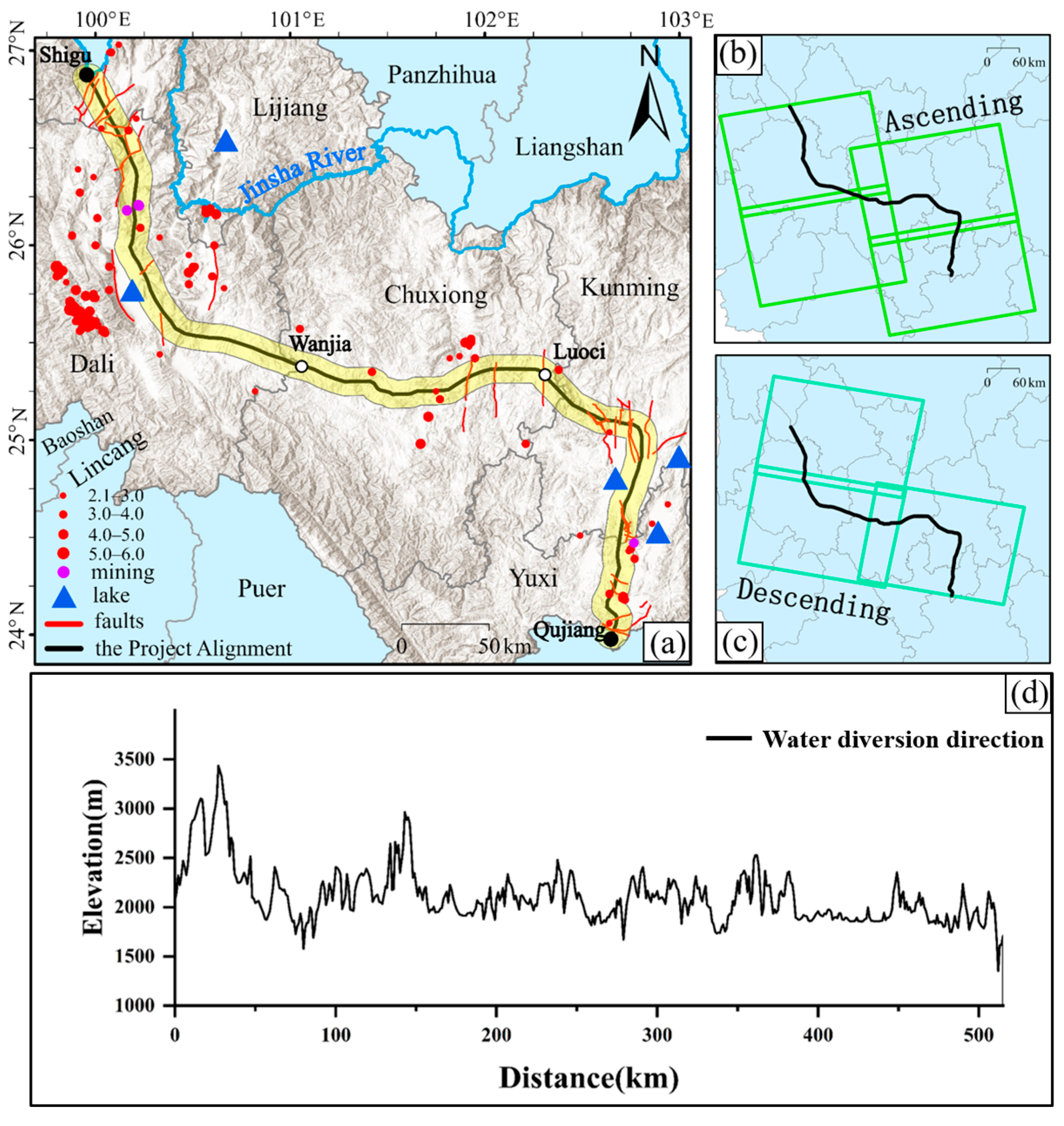
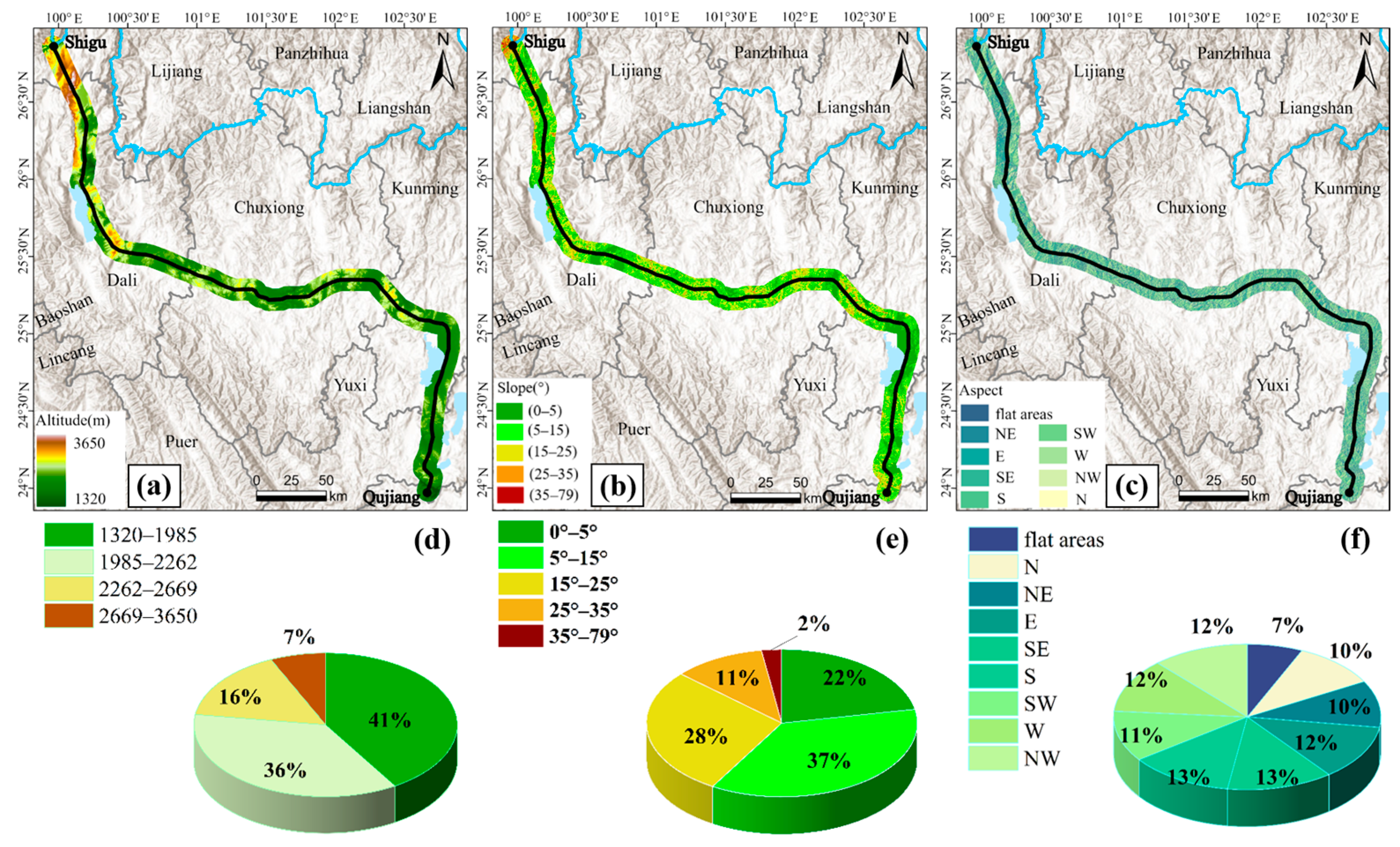
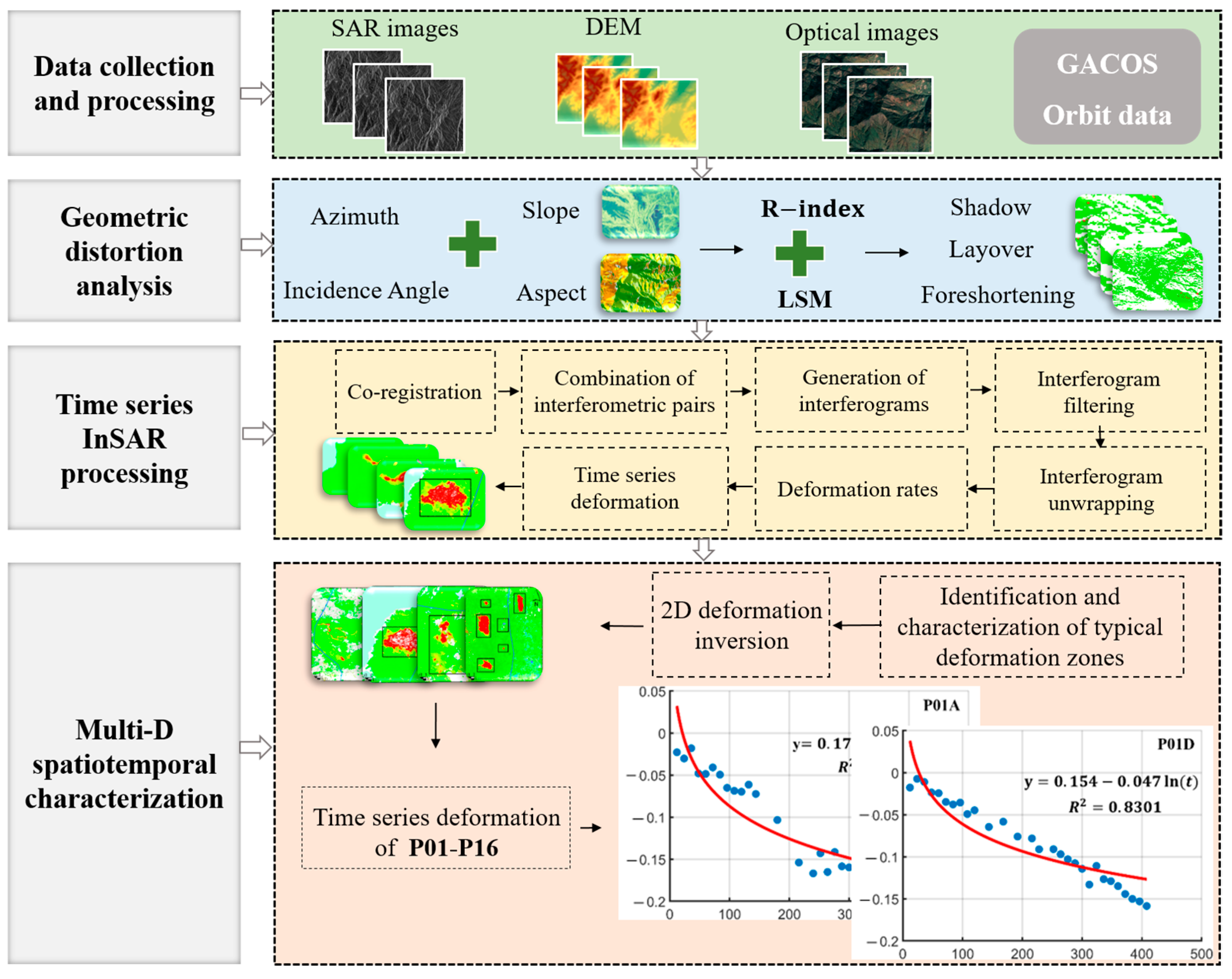
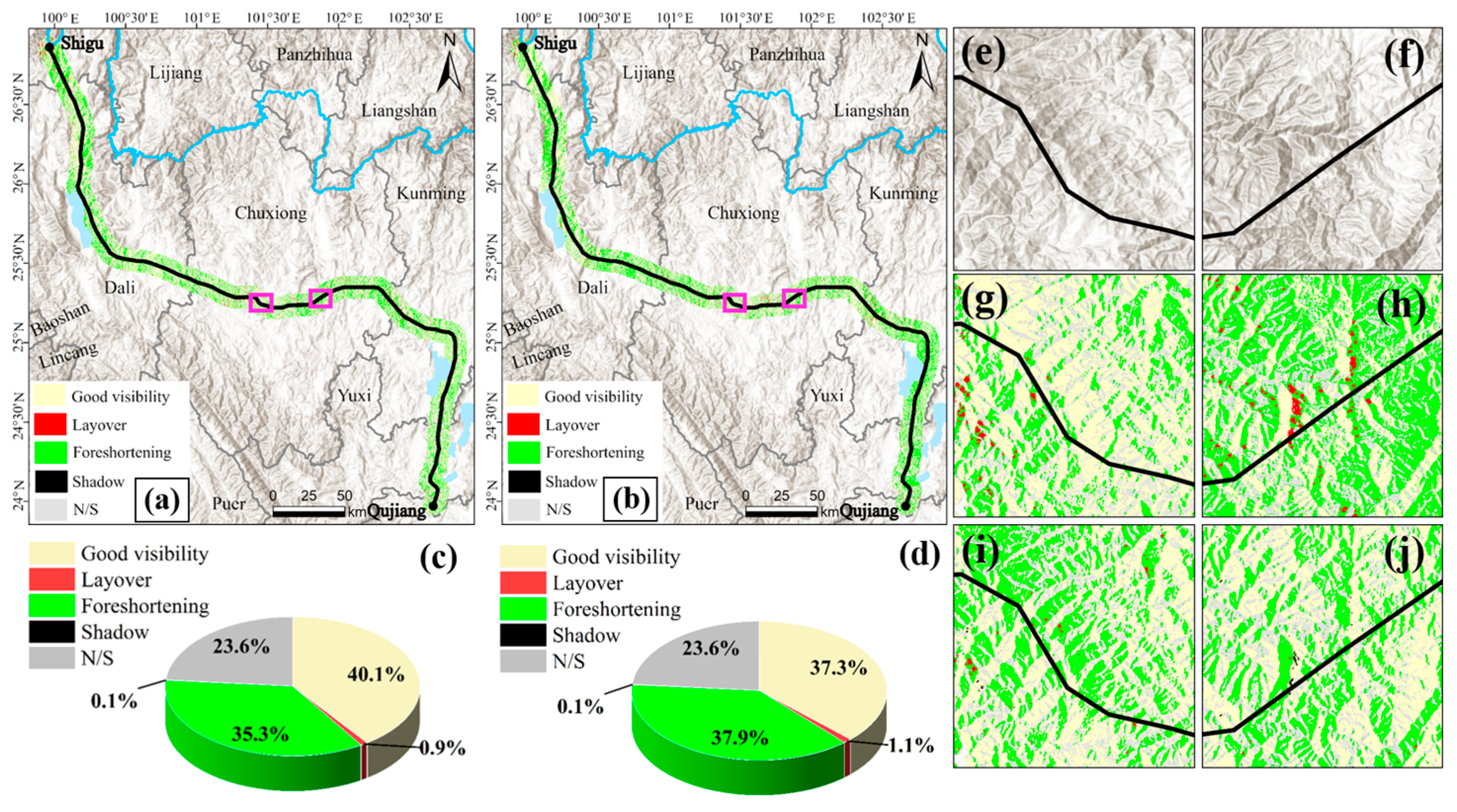

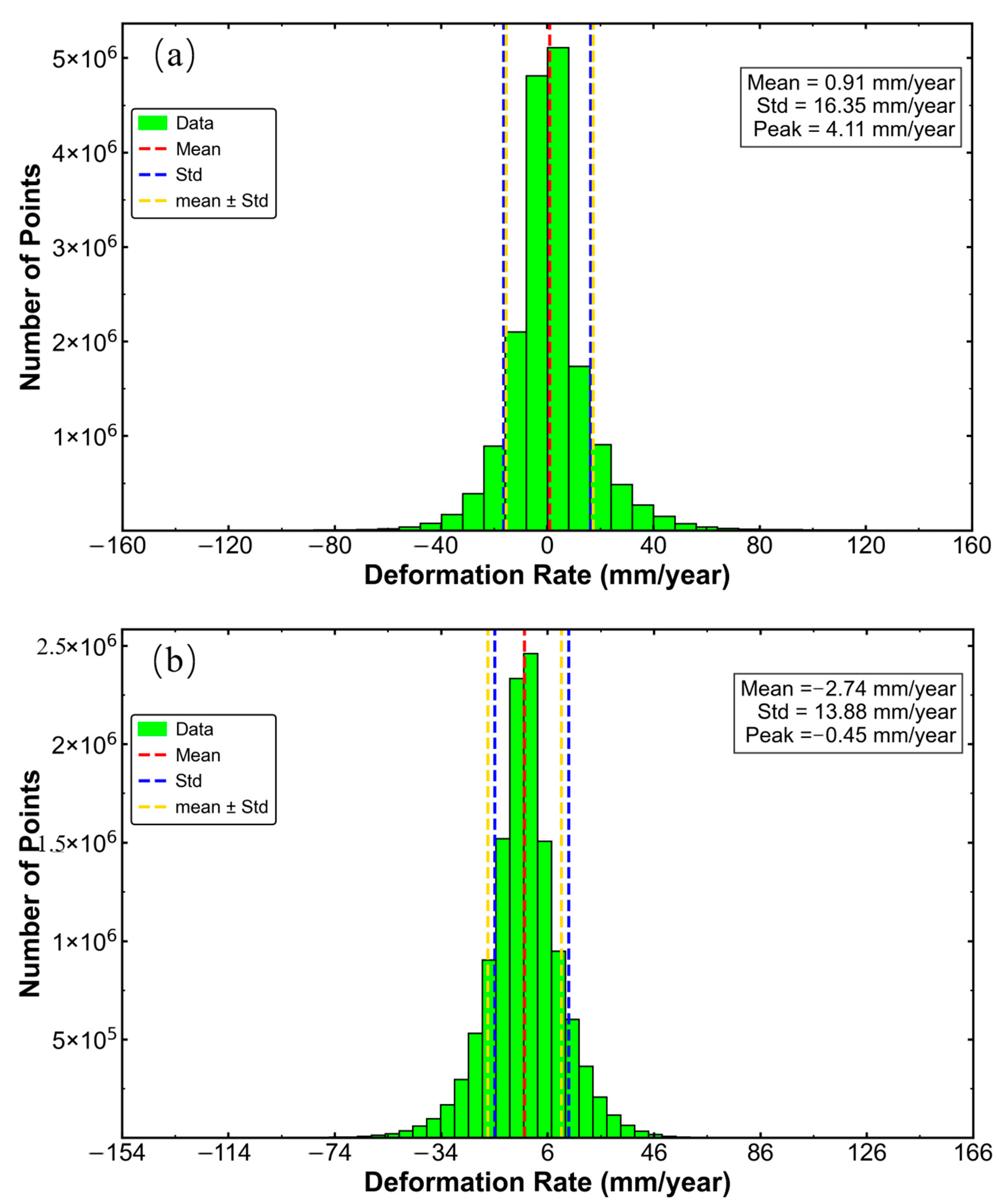
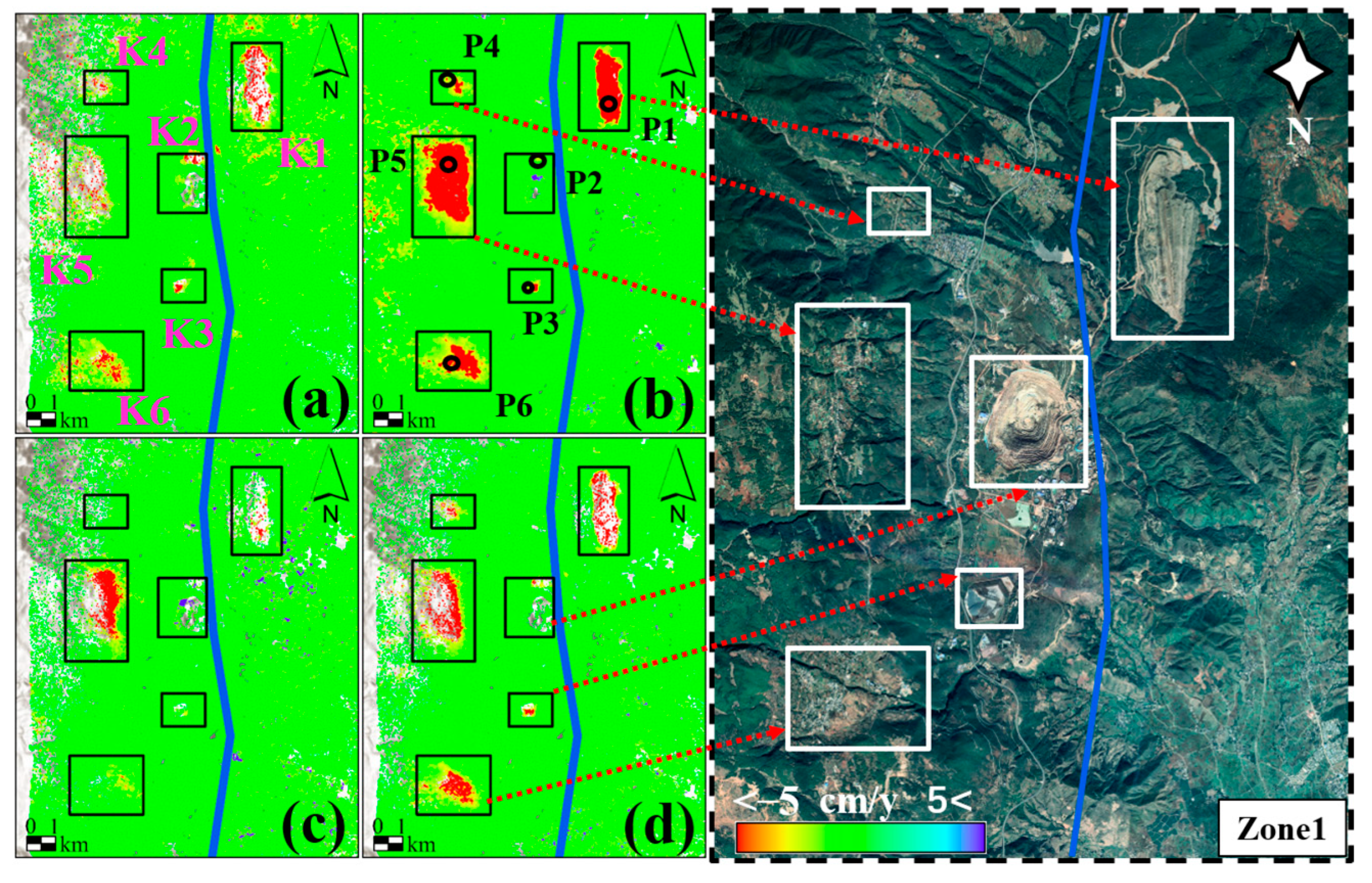
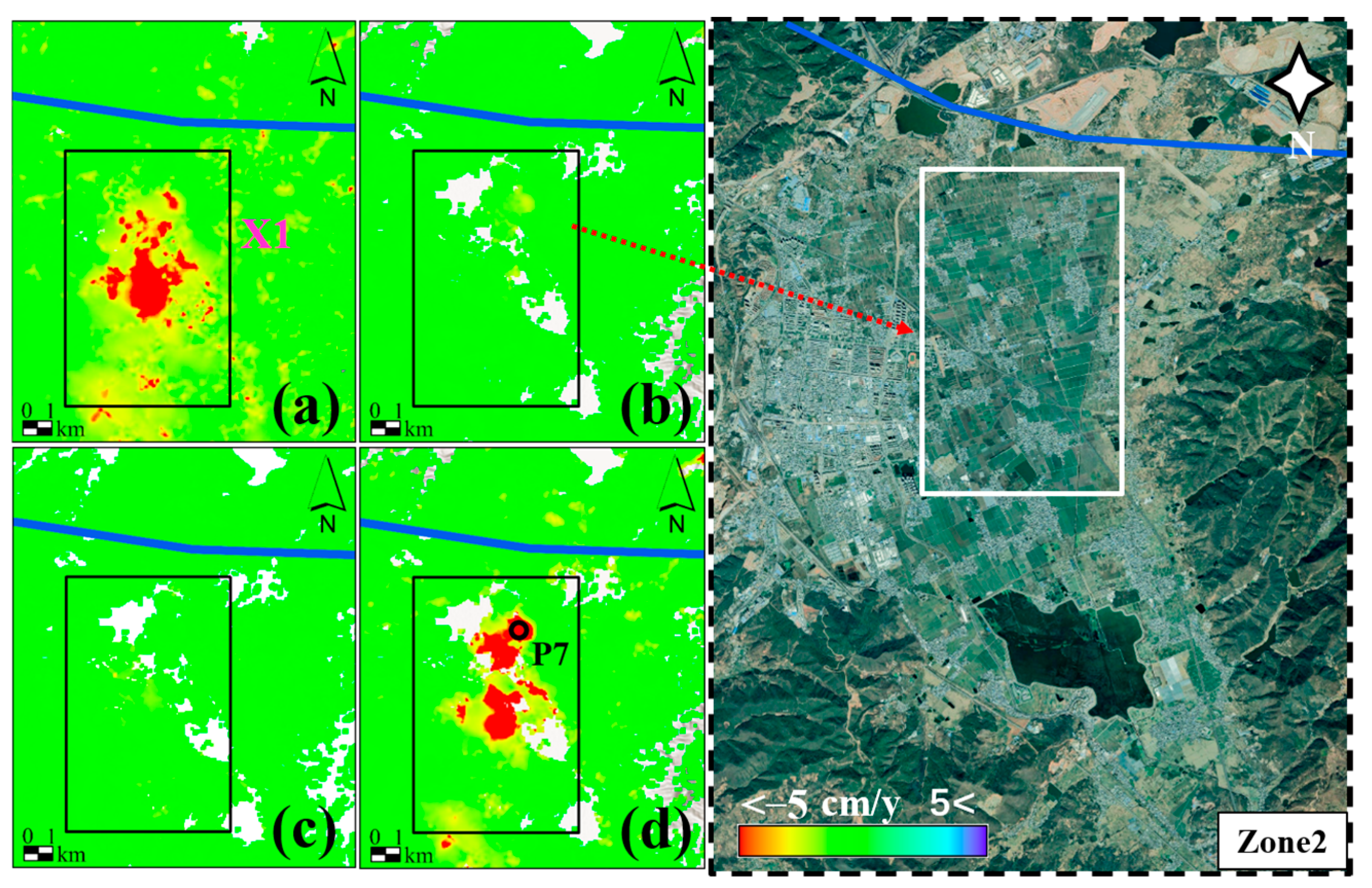
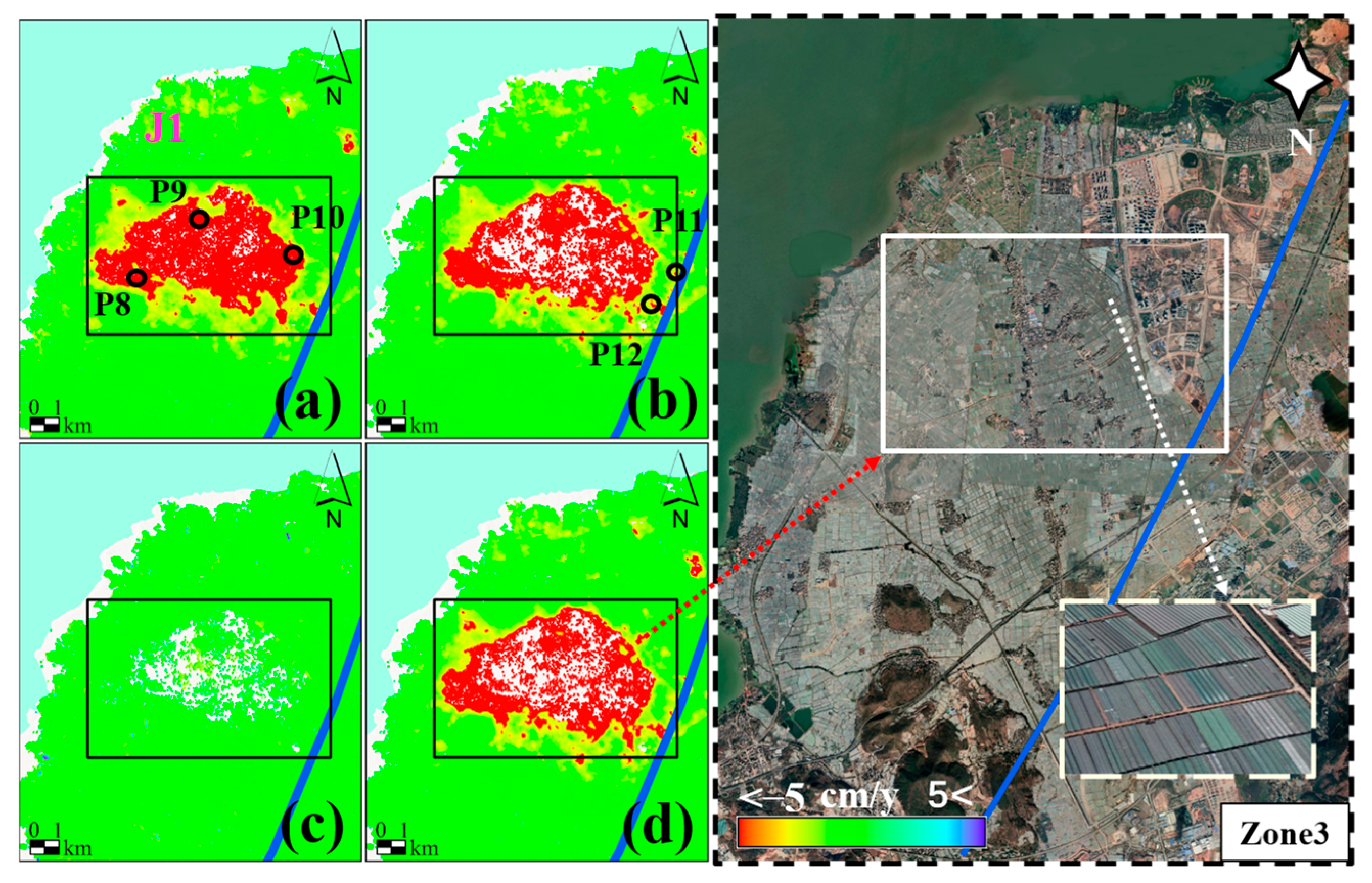
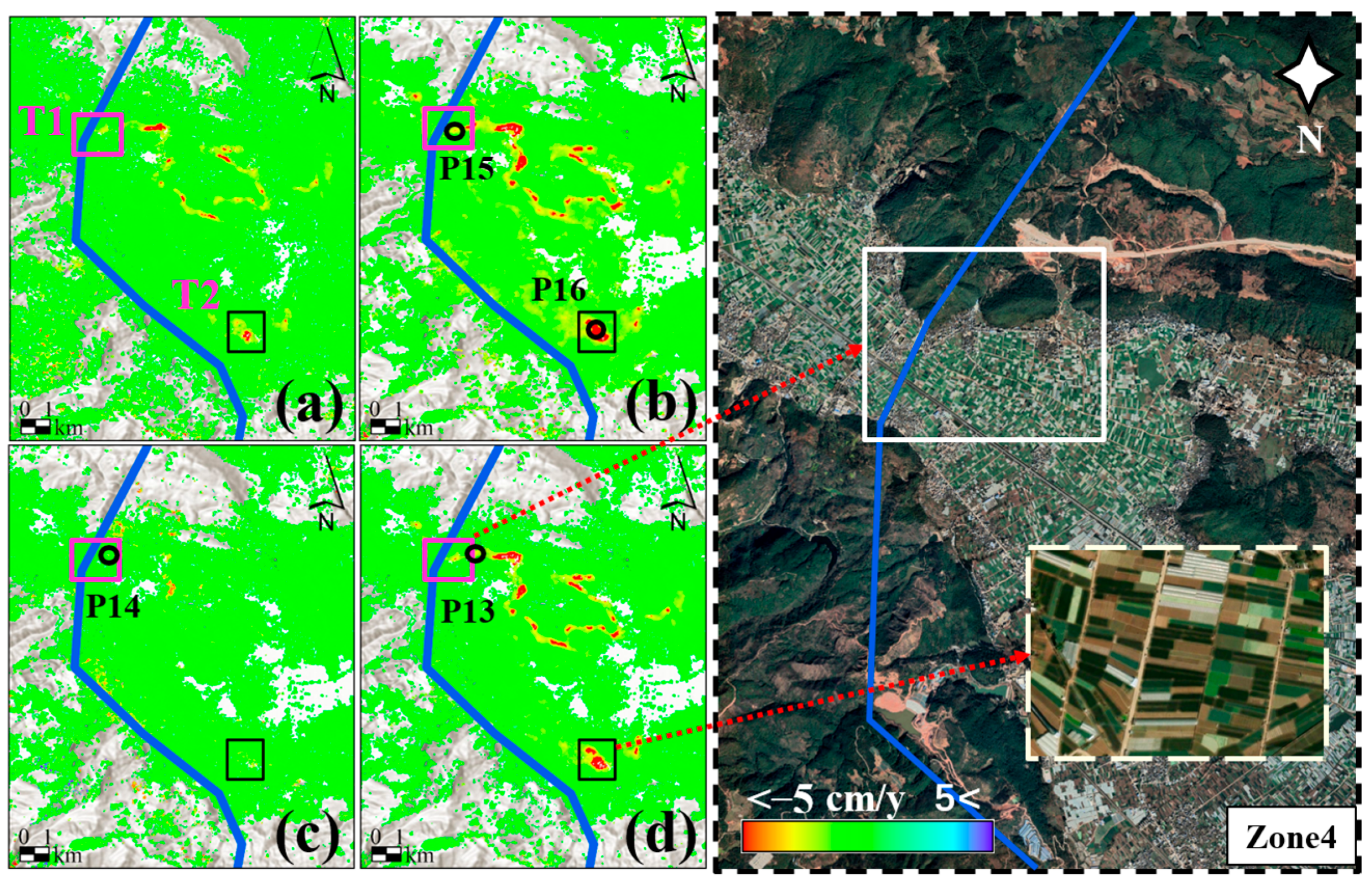
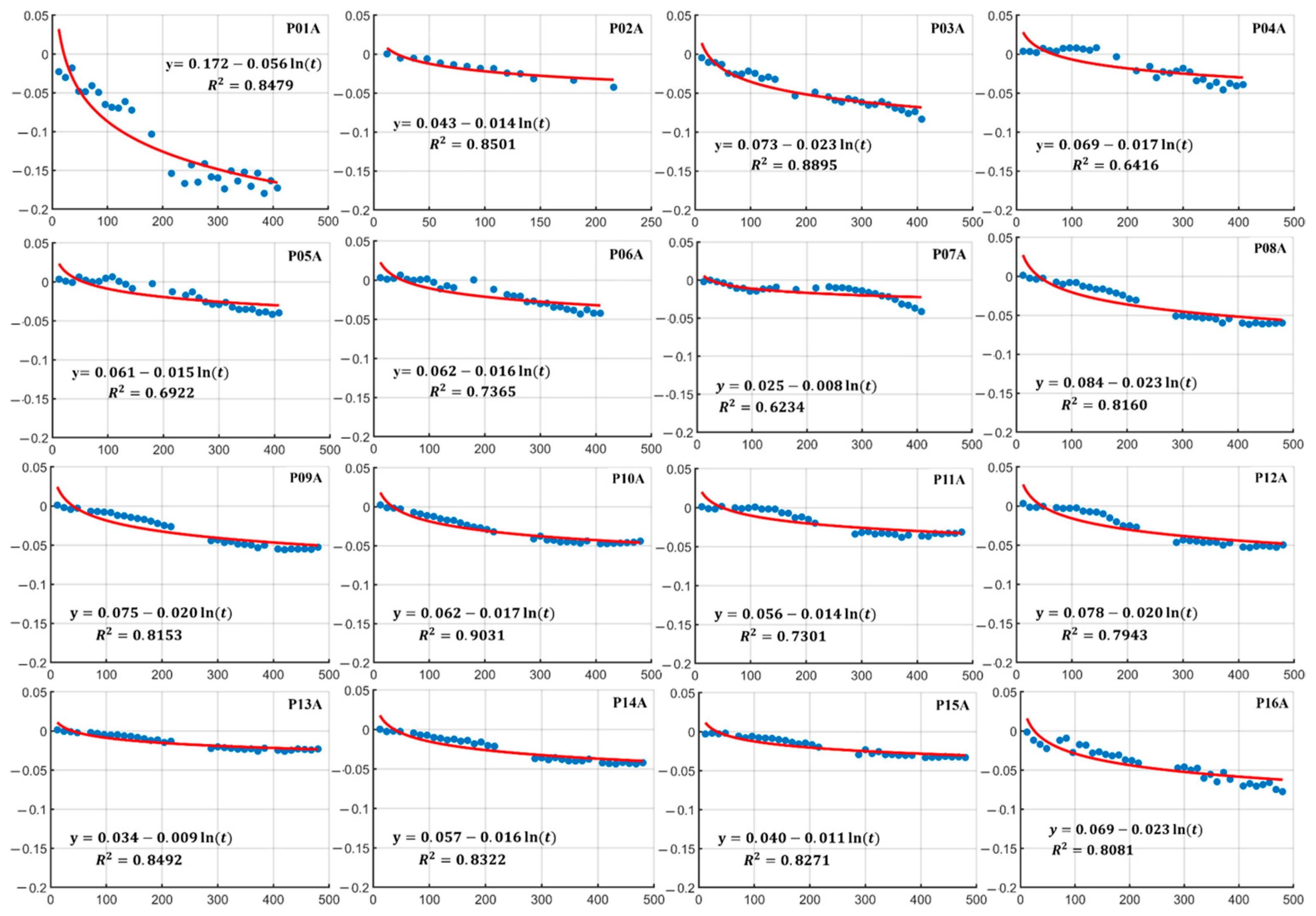
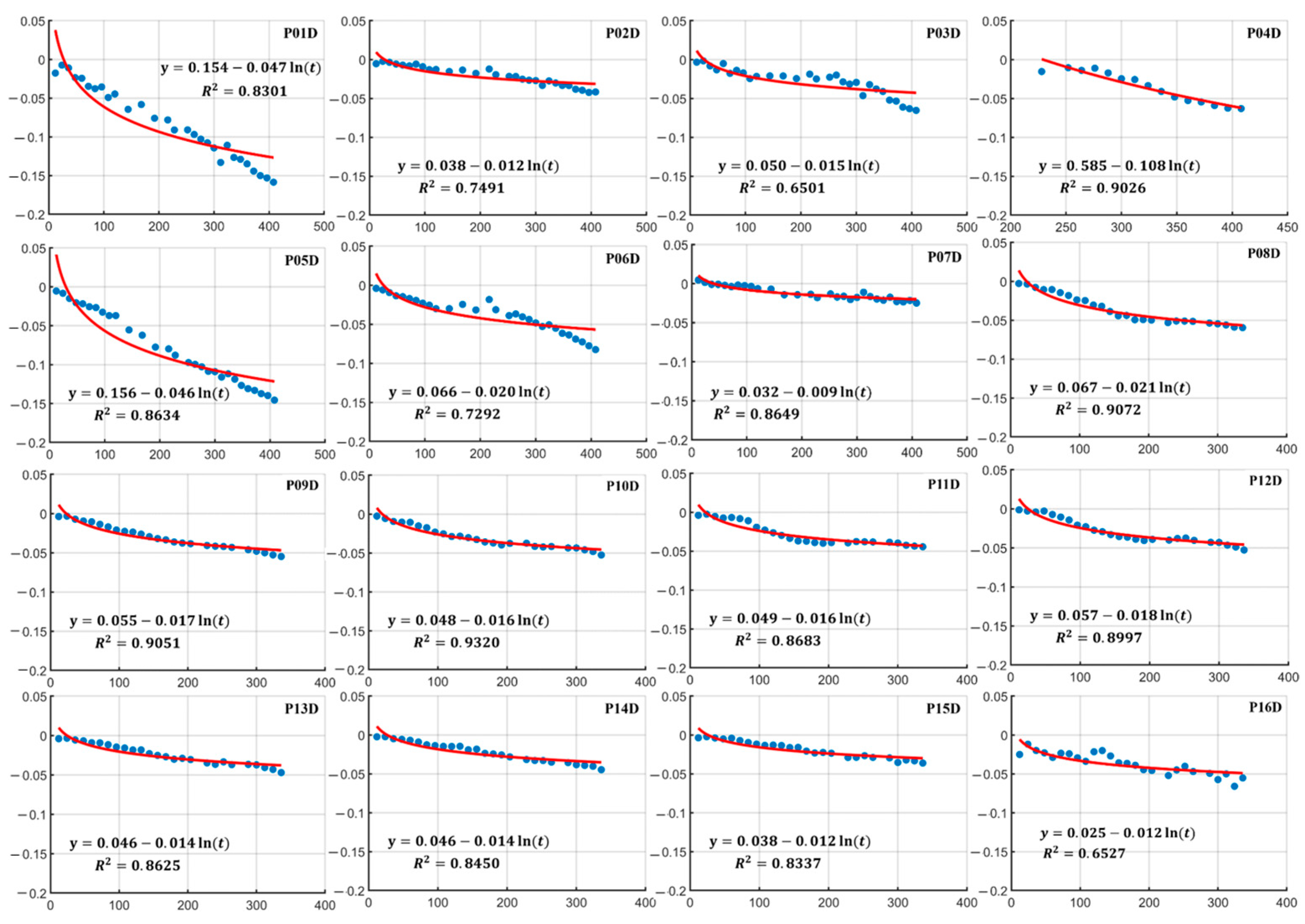
| Date | Location | Magnitude | Depth(km) |
|---|---|---|---|
| 21 May 2021 | Yangbi, Yunnan | 6.4 | 8 |
| 21 May 2021 | Yangbi, Yunnan | 5.6 | 10 |
| 21 May 2021 | Yangbi, Yunnan | 5.2 | 8 |
| 27 March 2017 | Yangbi, Yunnan | 5.1 | 12 |
| 21 May 2021 | Yangbi, Yunnan | 5 | 8 |
| 13 August 2018 | Tonghai, Yunnan | 5 | 7 |
| 14 August 2018 | Tonghai, Yunnan | 5 | 6 |
| Parameter | Ascending | Descending |
|---|---|---|
| Microwave band (wavelength) | C-band (5.6 cm) | C-band (5.6 cm) |
| Repeat cycle/d | 12 | 12 |
| Polarization | VV | VV |
| Path | 99, 26 | 135, 62 |
| Incidence angle (°) | 39.9 (99), 39.9 (26) | 39.9 (135), 39.9 (62) |
| Heading (°) | 347.5 (99), 347.5 (26) | 192.5 (135), 192.5 (62) |
| Pixel spacing(m) | 2.3 × 14 | 2.3 × 14 |
| Resolution(m) | 5 × 20 | 5 × 20 |
| No. of images | 124 | 90 |
| Temporal coverage | 25 October 2022–22 February 2024 | 31 December 2022–12 February 2024 |
| Area ID | Zone | Length (km) | Width (km) | Slope (°) | Distance to CYWDP (km) | Max Vert. Disp. (mm/y) | Max Hor. Disp. (mm/y) | Likely Phenomenon |
|---|---|---|---|---|---|---|---|---|
| K1 | Zone1 | 3.07 | 1.12 | 0~33 | 1.33 | −154 | −127 | Mining activities |
| K2 | Zone1 | 1.68 | 1.51 | 0~32 | 0.59 | −85 | 65 | Mining activities |
| K3 | Zone1 | 0.88 | 0.83 | 0~40 | 1.48 | −71 | −42 | Mining activities |
| K4 | Zone1 | 1.46 | 1.08 | 0~36 | 2.68 | −74 | −36 | Infrastructure construction |
| K5 | Zone1 | 2.94 | 1.65 | 0~52 | 3.78 | −154 | −114 | Infrastructure construction |
| K6 | Zone1 | 2.38 | 1.88 | 0~41 | 3.99 | −87 | −52 | Infrastructure construction |
| X1 | Zone2 | 5.70 | 3.75 | 0~5 | 3.77 | −53 | −41 | Urban engineering |
| J1 | Zone3 | 5.25 | 2.68 | 0~5 | 2.61 | −164 | −37 | Groundwater extraction, greenhouse farming, and urban engineering |
| T1 | Zone4 | 2.39 | 1.98 | 0~49 | 0.66 | −64 | −42 | Groundwater extraction, greenhouse farming, and urban engineering |
| T2 | Zone4 | 1.06 | 0.82 | 0~5 | 1.46 | −84 | −34 | Groundwater extraction, greenhouse farming |
Disclaimer/Publisher’s Note: The statements, opinions and data contained in all publications are solely those of the individual author(s) and contributor(s) and not of MDPI and/or the editor(s). MDPI and/or the editor(s) disclaim responsibility for any injury to people or property resulting from any ideas, methods, instructions or products referred to in the content. |
© 2025 by the authors. Licensee MDPI, Basel, Switzerland. This article is an open access article distributed under the terms and conditions of the Creative Commons Attribution (CC BY) license (https://creativecommons.org/licenses/by/4.0/).
Share and Cite
Gu, X.; Li, Y.; Zuo, X.; Huang, C.; Xing, M.; Ruan, Z.; Yu, Y.; Shi, C.; Xiao, J.; Zou, Q. Analysis of Geometric Distortion in Sentinel-1 Images and Multi-Dimensional Spatiotemporal Evolution Characteristics of Surface Deformation Along the Central Yunnan Water Diversion Project. Remote Sens. 2025, 17, 3250. https://doi.org/10.3390/rs17183250
Gu X, Li Y, Zuo X, Huang C, Xing M, Ruan Z, Yu Y, Shi C, Xiao J, Zou Q. Analysis of Geometric Distortion in Sentinel-1 Images and Multi-Dimensional Spatiotemporal Evolution Characteristics of Surface Deformation Along the Central Yunnan Water Diversion Project. Remote Sensing. 2025; 17(18):3250. https://doi.org/10.3390/rs17183250
Chicago/Turabian StyleGu, Xiaona, Yongfa Li, Xiaoqing Zuo, Cheng Huang, Mingzei Xing, Zhuopei Ruan, Yeyang Yu, Chao Shi, Jingsong Xiao, and Qinheng Zou. 2025. "Analysis of Geometric Distortion in Sentinel-1 Images and Multi-Dimensional Spatiotemporal Evolution Characteristics of Surface Deformation Along the Central Yunnan Water Diversion Project" Remote Sensing 17, no. 18: 3250. https://doi.org/10.3390/rs17183250
APA StyleGu, X., Li, Y., Zuo, X., Huang, C., Xing, M., Ruan, Z., Yu, Y., Shi, C., Xiao, J., & Zou, Q. (2025). Analysis of Geometric Distortion in Sentinel-1 Images and Multi-Dimensional Spatiotemporal Evolution Characteristics of Surface Deformation Along the Central Yunnan Water Diversion Project. Remote Sensing, 17(18), 3250. https://doi.org/10.3390/rs17183250






